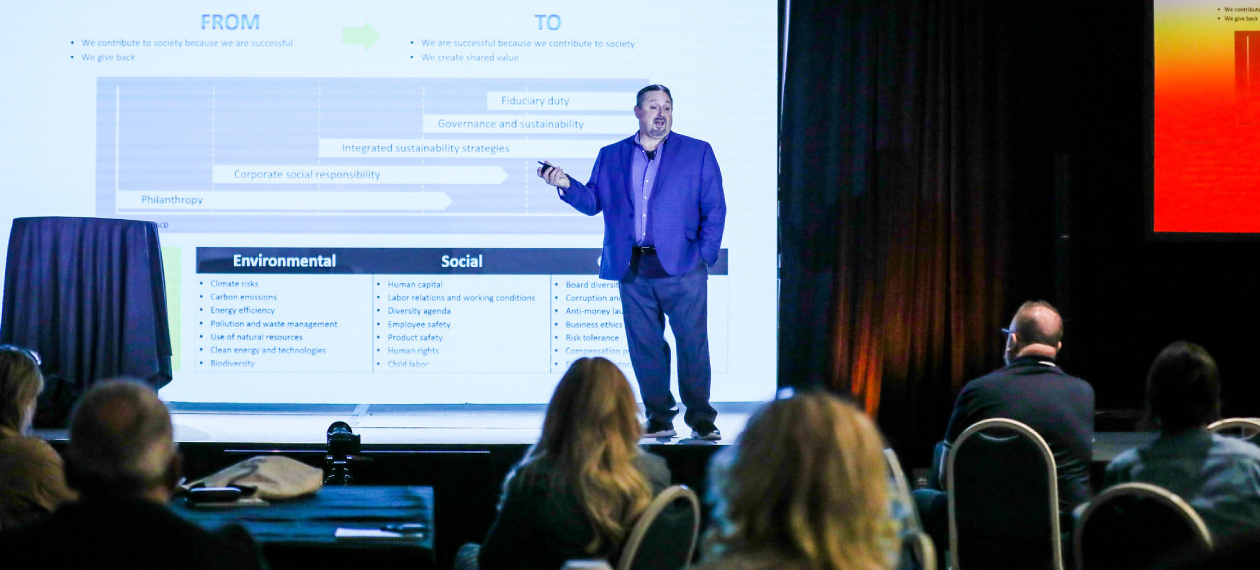The pressure for companies to develop robust Environmental, Social, and Governance programs is coming from all directions. The United Kingdom and Ireland already have ESG reporting regulations; similar frameworks under discussion in the European Union and Asia, with the United States surely soon to follow. Then there’s the upward pressure from the workforce: not only from existing employees increasingly concerned with health and safety in their workplaces, but also from prospective employees looking for a better home. “People aren't necessarily leaving in the Great Resignation because they hate their job or they hate their company,” said Jade Dauser, EY’s Corporate Real Estate & Technology Leader. “They're leaving because they want to find something more meaningful.”
Then there’s pressure from shareholders, who are starting to look at ESG considerations as they decide where to invest. Then there’s pressure from customers, who are starting to seriously consider whether their dollars are going toward companies focused on ESG. “The right of a company to do business is really based on people's willingness to buy from that company,” Dauser said. “And that shift in market perception is becoming bigger and bigger.”
So what does it take to develop a strong, meaningful ESG program that keeps all these stakeholders happy? In a presentation at WorkSpaces, Dauser offered a brief overview. He argued that while the task is daunting, the companies that rise to it will help build a better world—while enjoying the fruits of their own success.
“Something Significant and Something Verifiable”
What these mounting pressures ultimately mean is that strong ESG frameworks are no longer optional, but essential. Companies that may previously have gestured toward ESG for PR purposes are finding that the gesture is not enough: employees, customers, and investors want a real, meaningful commitment, and soon regulators will be joining the party too. “They’re demanding that there actually be something significant and something verifiable,” Dauser explained. “A lot of the types of systems that are being put in place now are focused on not only being able to demonstrate in numbers, but also demonstrate with an audit trail that what you're saying you're gonna do is actually happening.”
The problem, of course, is that what exactly constitutes a strong framework that satisfies every stakeholder is still something of a moving target. “The E part is actually fairly easy: most of us can understand environmental issues, most of us can understand environmental planning and… proving that you’ve got a decarbonization plan, you’ve got a pollution and waste management plan, all those kinds of things,” Dauser said. The Governance side of things, however, is still an open question as regulators craft regulations, and the Social prong is what Dauser described as “the giant hole in the middle.”
Are you doing this because it’s the right thing to do, or are you doing it because you have to do it?
And yet that S may also be the most important part of any ESG framework in the short-term, especially as it pertains to recruitment and retention. “If you can really engage with people on what that part of your program means, you’re gonna be able to answer the questions that they care about the most,” Dauser said. “Are you doing this because it’s the right thing to do, or are you doing it because you have to do it? Are you doing it because you care about coming up with new ways and new strategies of doing better, or are you just trying to check the boxes?” The answers to those questions might just mean the difference between a loyal, lasting workforce and endless churn.
A Multi-Faceted Approach
That’s not to say those answers will come particularly easily. ESG isn’t plug-and-play, but rather requires a holistic approach from the entire organization. “If you try to find a silver bullet, it’s not gonna work,” Dauser stressed. “You can't appoint one person to be your ESG czar and think that that's gonna fix everything. It won't work. You really have to understand—how are you gonna look at this through your HR department, through your finance department, through your real estate and facilities departments. People have to understand that this is a multi-pronged problem, and it's gonna require a multi-faceted approach to solve it.”
“You have to focus on getting the right people within your organizations focused on their portion of the solution, and then getting them talking to each other,” he continued, holding up his own 300,000-person company as an example. “Solving this for EY is as gigantic a problem as it is for pretty much any other company in the world. And so what we're discovering is that we have to identify in-region resources who are focused on this, and who are thinking about what the local color is on the question. What are the local customs? What are the local things that have to be considered as part of the overall strategy?”
“Focus on getting the right people within your organizations focused on their portion of the solution, and then getting them talking to each other”
Transparency, as always, is key. Employees (and other stakeholders) will want to know what’s being done, and why, at every step of the process. While this may be uncomfortable for executives unaccustomed to that level of transparency, Dauser said, the discomfort will be well worth it. “In many cases, you're actually asking companies to start to do things that they might perceive to be against their own best interests,” he explained. “In some cases you might actually be looking at increasing the cost of providing services in some of your facilities, you might actually be providing things that you would never have otherwise considered providing, because it was just never part of your thinking. That transparency around that kind of thing is going to be hugely valuable to your success as an organization.”
The Burning Issue of Our Time
Real estate and facilities teams will shoulder much of the heavy lifting in the average company’s ESG efforts. “Somewhere on the order of 60% of the things that are gonna be considered reportable components of an ESG program are gonna be things that can be measured or managed by your real estate and facilities group,” Dauser said. “This is where your decarbonization strategy can happen. This is where you can have all kinds of different ways that you’re managing the environment… There are things that you can really address, and through a really well deployed digital real estate strategy, you can start to measure and monitor things in a way that becomes auditable, which is really gonna be a key factor in some of these things going forward.”
In closing, he recommended that company leaders have an open mind, a willingness to be uncomfortable, and an empathetic eye for what their people need and want. “Aim for that cohesive narrative, to all the types of stakeholders you have,” he said. “We need companies to step up, take a leadership role, show each other how they're doing it, show each other what can be done and understand that it's gonna take a community minded-approach to these kinds of questions, to be able to drive real success in the world—and also to address the burning issue of our time.”

Posted by
Join us at WorkSpaces!
The retreat for corporate real estate and workplace innovators.
Oct 4-6, 2026 | Santa Barbara, CA




-3.png)
-3.png)


-2.png)

Comments